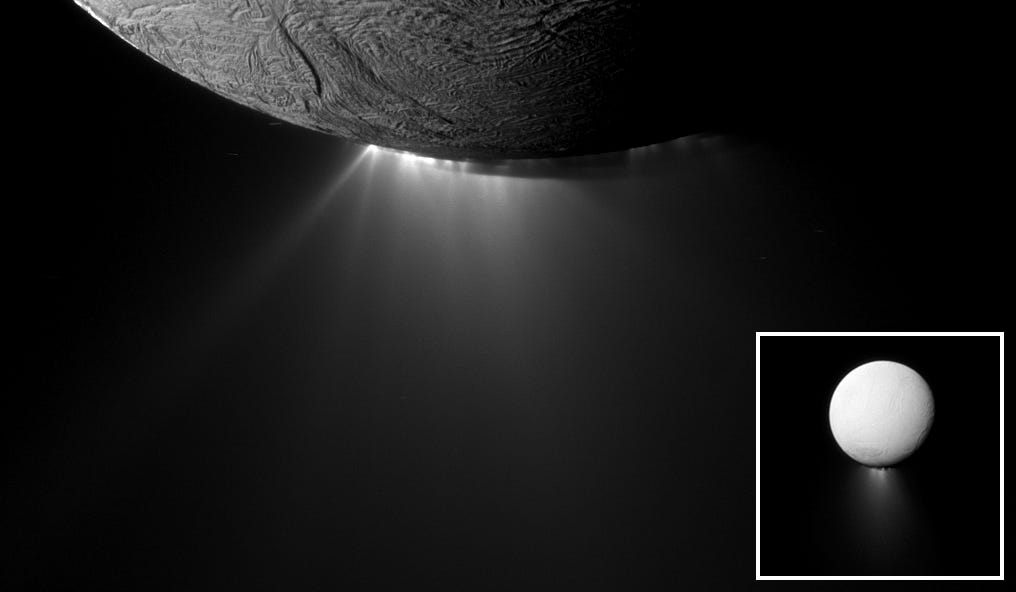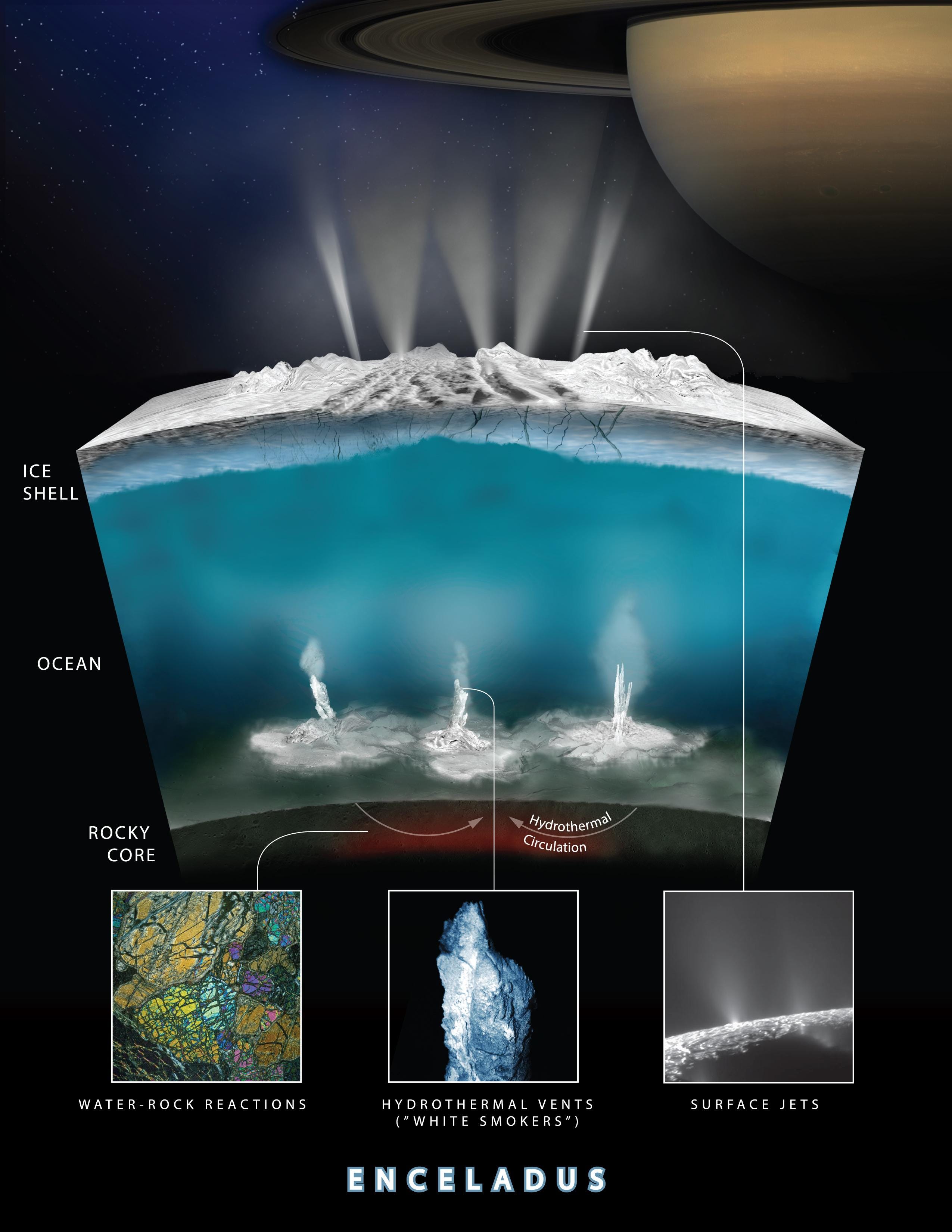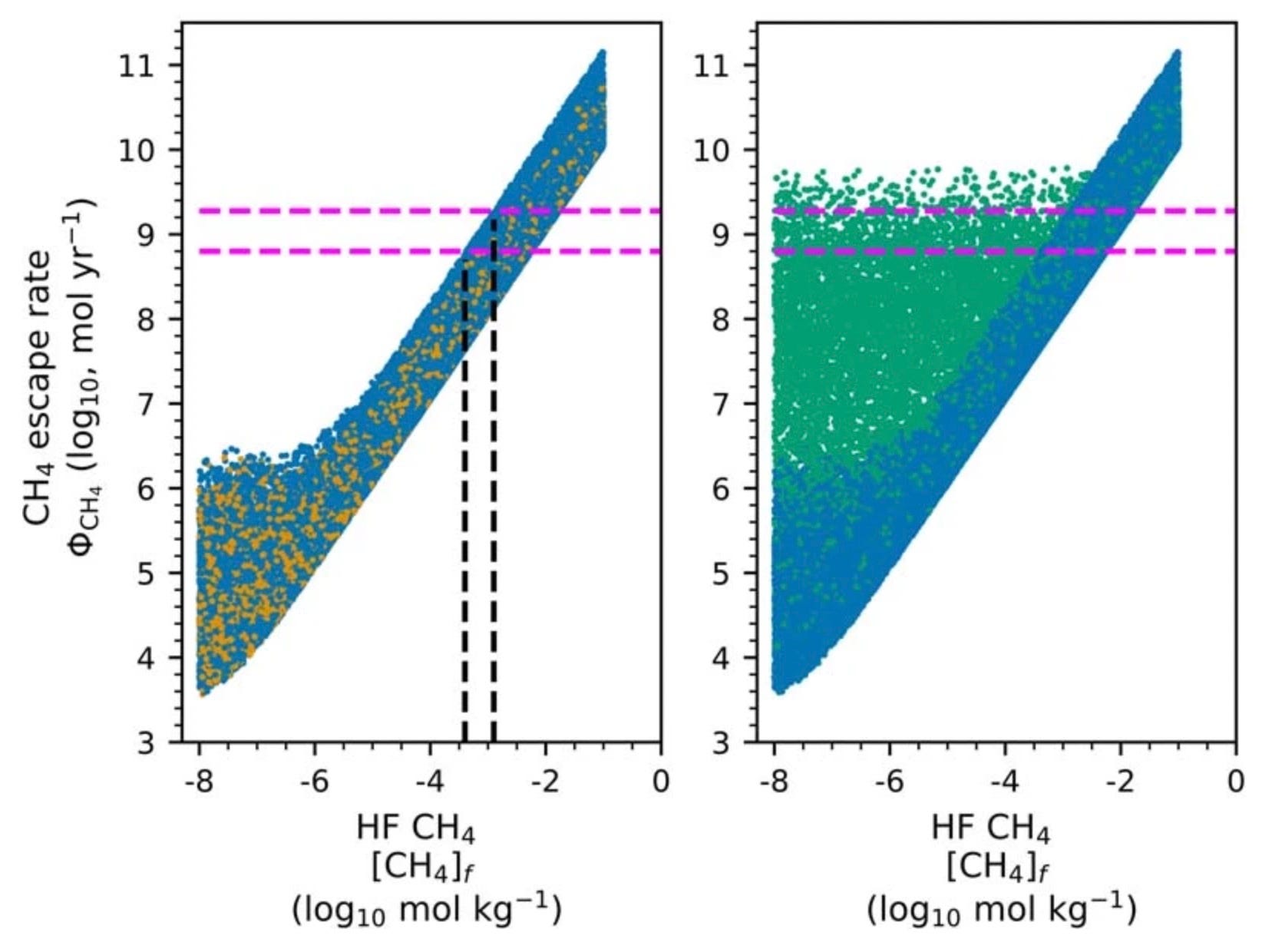Water plumes from Saturn’s icy moon may show promising signs of life
New research says methane levels in Enceladus’ plumes might point to a habitable world.
Saturn’s small, icy moon Enceladus captured the imaginations of people worldwide when NASA’s Cassini spacecraft saw it spewing plumes of water into space. This water comes from a global, liquid ocean concealed beneath Enceladus’ fissured crust.

As Cassini flew through Enceladus’ plumes between 2008 to 2015, its mass spectrometer found a variety of organic molecules—building blocks of life—coming from the moon’s ocean. Cassini also detected molecular hydrogen, carbon dioxide, methane and rock fragments hiding within the moon’s plumes.
Though the Cassini mission ended in 2017, researchers are still combing through its plume data to get better insight into Enceladus’ ocean. Recent studies of Cassini data showed that Enceladus’ plumes contain higher levels of hydrogen as well as more carbon dioxide and methane than previously thought, increasing intrigue about what’s happening inside the moon.
What could Enceladus’ ocean be like?
Cassini’s observations suggest that Enceladus’ ocean seems to have hydrothermal vents similar to those found in the deepest, darkest parts of Earth’s oceans. Here, water seeps into Earth’s rocky crust and gets heated near magma, then erupts through hydrothermal vents on ocean floors, along with various chemicals. Not only do various microorganisms like methanogens thrive near such vents scientists think this is how life on Earth could have started in the first place.
Methanogens on Earth don’t have access to direct sunlight; instead, they derive their energy by converting carbon in the ocean and molecular hydrogen released from hydrothermal vents into methane. While geological processes powering these vents also produce methane, methanogens release the majority of the gas. Could something similar be happening in Enceladus’ ocean?
Unfortunately, we don’t yet have the technology to send missions inside Enceladus’ ocean and hunt for life there. So instead, a new study published in Nature Astronomy modeled how likely it is for Earth’s methanogens to survive in Enceladus’ ocean and produce the plume gases observed by Cassini. And the results say it’s plausible!
What the new research says
The authors of the study made complex mathematical models based on known physics and chemistry to simulate possible environments on Enceladus’ ocean floor. Each simulation took one of the plausible composition and temperature values of both Enceladus’ ocean and fluids released from its hydrothermal vents, and ran the mathematical model to see what kind of aquatic environment it forms. This gave them thousands of possible hydrothermal environments which would spew different concentrations of gases into Enceladus’ plumes depending on the intricately different physical and chemical processes at play.

High carbon dioxide levels measured by Cassini also indicated that Enceladus has an Earth-like ocean floor—in terms of temperatures, salinity, and acidity—so scientists were curious if Earth’s methanogens could survive there. They introduced several breeds of our methanogen populations into Enceladus’ simulated hydrothermal environments to see which and how many of the latter provide enough food for the microbes to grow. Out of 50,000 simulated environments, 32% were habitable and allowed the methanogens to thrive while the rest didn’t. This means there’s a chance Enceladus’ ocean is friendly to Earth’s methanogens.
The authors of the study then looked into how the methanogens could alter the habitable environments over time. This would, in theory, also impact the gas levels we can measure in Enceladus’ plumes. Simulations where methanogens could thrive consistently produced carbon dioxide and methane levels matching Cassini’s observations, and non-biological simulations didn’t. This was especially true for methane where even the best case scenarios for natural processes, like serpentinization, produced gas levels far from what Cassini observed. With Earthly microbes thrown into the mix, the methane levels fell right in range of Cassini’s measurements.

Another interesting find was that the simulated microbes consumed only a small amount of hydrogen released from hydrothermal vents, meaning high levels of it in Enceladus’ plumes can’t be taken as signs of absence of life.
So is there life on Enceladus?
Simply put: we don’t know. This research suggests that certain microorganisms could hypothetically survive on Enceladus’ ocean floors.
There are a few ways we can explain methane levels observed by Cassini: we can assume methanogens exist there or invoke new kinds of physical and chemical processes taking place on Enceladus that are foreign to Earth. The latter could mean completely rethinking how Enceladus formed.
If comets bombarded Enceladus during its formation, the Saturnian moon could have gotten methane and/or organic molecules from them directly. Methane in the moon’s interior could leak via outgassing, and organics in Enceladus’ heated core could decompose to release hydrogen, carbon dioxide and methane. It’s difficult to pursue these possibilities because we don’t know how Enceladus formed, or how to quantify the amount of methane it releases.
Scientists have extended their simulations based on the Bayes mathematical framework, which tells us how likely an event is based on how likely its prerequisite conditions are. In other words, if the chances of life emerging on Enceladus soon after its formation were high, then the likelihood of a thriving microbial environment in its ocean today is very high. But if we assign a low probability of life emerging on Enceladus, research suggests its oceans are habitable yet uninhabited, meaning methane and organic material accumulated during the moon’s formation are likelier sources of gases measured by Cassini.
Things essentially boil down to understanding how Enceladus’ formed and evolved. How will we get to know that? Send more missions, of course.
More missions to this moon’s plume, please
Even as Cassini was flying through Enceladus’ plumes, scientists were proposing new missions. One such concept is the Enceladus Life Finder, which would use a much more powerful mass spectrometer than Cassini to look for direct signs of life in the icy moon’s plumes. The upcoming James Webb Space Telescope can remotely observe the plumes and potentially identify non-biological sources of methane. Spacecraft taking measurements of carbon and nitrogen isotopes—different subatomic forms of the same element—in the plumes will provide telltale signs of what comprises Enceladus’s core and thus help determine the moon’s origin.
While NASA will launch Dragonfly later in the decade to Titan, another potentially habitable moon of Saturn, no space agency is currently funding a mission to Enceladus.
Finding life in Enceladus’ alien oceans would be nothing short of life-changing. It’s perhaps even more exciting to find microbial life in our solar system than intelligent life in another. That’s because if life formed and survived independently in our solar system on two completely different worlds, it boosts the idea that the universe is teeming with life.
Originally published at The Planetary Society.
Like what you read? Support me to keep me going.
